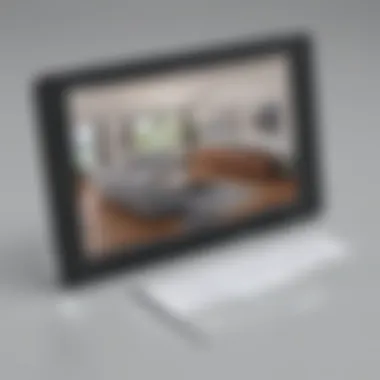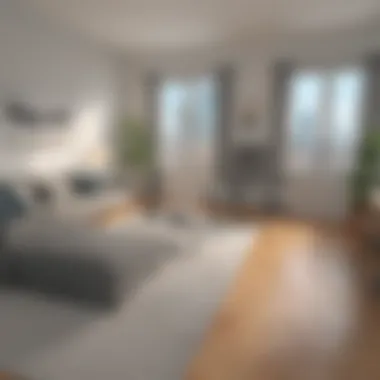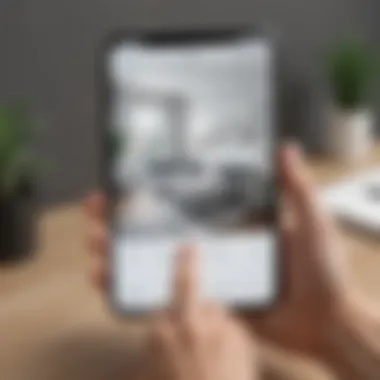RoomSketcher App Reviews: In-Depth Analysis & Insights


Intro
The RoomSketcher app has increasingly gained attention among businesses and individuals looking for effective design software. This analysis delves into its capabilities, features, and overall user experience to inform potential users on the application's strengths and weaknesses. By identifying the core aspects of the software, we aim to assist decision-makers in choosing the right tool for their specific design needs. Understanding the functionalities and user feedback is crucial in today’s competitive business landscape, particularly for small to medium-sized enterprises, entrepreneurs, and IT professionals.
Overview of Features
Highlight Significant Functionalities
RoomSketcher offers a variety of features aimed at enhancing the user experience in design and visualization. Users can create 2D and 3D floor plans with simple drag-and-drop tools. This capability allows for quick adjustments and a more intuitive design process, making it accessible to both novices and experienced designers alike. Additionally, the app includes a vast library of furniture and fixtures that can be easily integrated into designs, allowing for realistic presentations.
Other notable features include the ability to visualize designs in 3D from different angles. This immersive approach helps users better understand spatial relationships and finalize designs with confidence. Furthermore, the app supports high-quality rendering, enabling users to generate lifelike images for presentations or marketing materials.
Explain How They Benefit Users
These functionalities significantly benefit users by streamlining the design process. The drag-and-drop interface eliminates the need for complex software skills, which can often hinder creativity. By providing easy access to a range of design elements, users can experiment and iterate on their ideas without feeling restricted.
The 3D visualization further enhances this benefit by allowing for immediate feedback on design choices. Users can visualize the end product before physical implementation, which is invaluable for reducing mistakes during construction or renovation. Overall, the combination of ease of use and advanced visualization tools makes RoomSketcher a compelling choice for design projects.
Unique Selling Points
What Sets This Software Apart from Competitors
RoomSketcher stands out in a crowded market of design software due to its user-friendly interface combined with robust functionality. Unlike some competitors that target professional designers only, RoomSketcher caters to a broader audience. This makes it suitable for homeowners, small business owners, and professional designers alike. It blends simplicity with depth, making it efficient for quick projects as well as detailed architectural work.
Emphasis on Innovation or Specific Capabilities
The app’s innovative features such as mobile compatibility add to its unique appeal. Users can create designs from their tablets or smartphones, providing flexibility for working on-site or during meetings. This capability aligns with the growing trend of remote work and the need for access to design tools on-the-go.
Moreover, RoomSketcher frequently updates its features based on user feedback. This responsiveness to the needs of its audience reflects a commitment to continuous improvement, positioning the software as a reliable choice for both current and future projects.
"In the realm of design tools, adaptability and user-centric design are paramount. RoomSketcher manages to achieve both, translating to satisfied users across various industry segments."
The comprehensive analysis of RoomSketcher will continue further, examining user experiences, potential drawbacks, and alternatives that may exist in this domain.
Preamble to RoomSketcher
Understanding the RoomSketcher application is crucial for anyone who is serious about design and visualization, especially business professionals. This section provides an insightful overview of the software, touching upon its functionality and purpose. It highlights the importance of effective design tools in today's competitive market, where visual presentation can significantly influence success.
Overview of the Application
RoomSketcher is a versatile design tool popular among architects, designers, and real estate professionals. It offers users the ability to create floor plans and 3D visualizations. Its intuitive interface facilitates a relatively seamless user experience, which is essential for those who may not have extensive design expertise.
The application is equipped with features such as drag-and-drop functionality, which simplifies the design process. Users can select pre-made objects, such as furniture and fixtures, to furnish their designs effectively. The ability to visualize spaces in both 2D and 3D contributes to a comprehensive understanding of design possibilities, making it a valuable tool for various sectors, including real estate and interior design. Users appreciate its ability to produce realistic renderings thereof can enhance presentations and client engagements.
Target Audience and Use Cases
RoomSketcher caters to a diverse audience. It is especially beneficial for small to medium-sized businesses, entrepreneurs, and IT professionals involved in design-related projects.
The primary use cases include:
- Interior Design: Designers use RoomSketcher to draft client concepts and proposals, which can speed up the decision-making process.
- Real Estate: Agents and property developers create attractive visual content to help market properties more effectively.
- Event Planning: Users can design layouts for corporate events, weddings, and other gatherings to optimize space usage.


In essence, RoomSketcher is a crucial resource for anyone looking to transform ideas into tangible concepts. By considering the needs of distinct user groups, the application ensures that it remains relevant and functional across various fields.
Key Features of RoomSketcher
Examining the key features of RoomSketcher is crucial for understanding its utility and appeal. This section provides comprehensive insights that can guide potential users in determining whether this application meets their specific needs. Understanding the features will help users optimize their design projects efficiently.
User-Friendly Interface
RoomSketcher presents an intuitive and user-friendly interface that simplifies the design process. The layout is straightforward, allowing users, regardless of their expertise, to navigate without frustration. Tools and options are logically grouped, which reduces the time spent searching for specific functions. The drag-and-drop functionality accelerates the creation of layouts, making the software accessible to beginners. Users have noted that this approach enhances productivity. The interface allows users to focus more on creativity rather than grappling with complicated settings.
Design and Visualization Tools
The design and visualization features in RoomSketcher offer a robust toolkit for both amateurs and professionals. Users can create various floor plans, selecting from numerous templates to start their designs. Customization options enable detailed alterations to dimensions and room layouts. Additionally, advanced tools like the room planner allow for precise measurements, which is especially important for businesses that require accuracy.
Visualization aids, such as color schemes and material selections, enhance the design experience. Users can view changes in real time. This means that adjustments can be made quickly, fostering a dynamic workflow. Accurate visualization is vital in client presentations, and RoomSketcher excels in this area.
3D Visualization Capabilities
3D visualization is one of RoomSketcher's standout features. The app allows users to switch from 2D plans to 3D views with ease. This capability enables clients to see potential designs from a realistic perspective before any actual construction occurs. The feature is essential for those looking to impress stakeholders.
Moreover, the ability to create walk-through animations enhances the experience. Users can navigate through their designs virtually, providing an immersive way to evaluate the layout. This is particularly beneficial for real estate professionals who aim to showcase properties effectively.
Mobile Accessibility
RoomSketcher provides mobile accessibility, which is increasingly important in today's fast-paced work environment. Users can access the application from various devices, including tablets and smartphones. This flexibility allows for working on the go, enabling entrepreneurs and busy professionals to make adjustments whenever necessary.
The mobile version retains many functionalities of the desktop version, ensuring that users do not miss out on essential tools. This capability aligns with the needs of small to medium-sized businesses, where time and mobility play crucial roles. Users have appreciated the seamless transition of their projects between devices, ultimately enhancing their productivity.
"The combination of user-friendly tools and mobile access makes RoomSketcher an ideal choice for today’s design needs."
Advantages of Using RoomSketcher
RoomSketcher stands out among design applications due to its numerous advantages, making it a viable choice for small to medium-sized businesses and entrepreneurs. These benefits enhance the overall user experience and efficiency in implementing design projects. Here, we discuss the three primary advantages: efficiency in the design process, collaboration features, and cost-effectiveness.
Efficiency in Design Process
One of the most significant advantages of RoomSketcher is its ability to streamline the design workflow. The application offers intuitive tools that allow users to create detailed floor plans and 3D models quickly. Users can easily drag and drop elements into their designs, which saves time compared to more complex software.
Moreover, RoomSketcher enables users to visualize their ideas effectively. The ability to switch between 2D and 3D perspectives helps in making real-time adjustments. This feature greatly enhances decision-making, as users can see the potential of their design before finalizing it.
"Efficiency in design is not just a time-saver; it’s a pathway to creativity. RoomSketcher facilitates rapid visualization which is crucial for modern design processes."
Collaboration Features
Another prominent advantage is the collaboration capabilities included in RoomSketcher. The application allows multiple users to work on a project simultaneously. This is particularly useful for teams or business partners who can provide input and modifications in real-time. Such features can significantly improve communication and reduce misunderstandings, leading to a more coherent design outcome.
In addition, projects can be shared with clients easily. Users can generate links or export images, enabling seamless presentations. With these tools, collaboration turns into a far more engaged process, fostering greater client satisfaction and successful project completions.
Cost-Effectiveness
Finally, RoomSketcher offers considerable cost advantages. Many small businesses and entrepreneurs often face budget constraints when selecting design software. RoomSketcher's pricing structure caters to these needs by providing both free and premium plans.


The free plan offers a decent array of basic features. For those needing advanced functionalities, the premium plan presents additional tools while maintaining affordability. This flexibility allows users to choose a plan that aligns with their budget and requirements. The ability to efficiently complete projects without exorbitant costs enhances the overall value of RoomSketcher.
In essence, the advantages of using RoomSketcher make it an attractive option for those in need of design software. Its efficiency in the design process, robust collaboration features, and cost-effectiveness contribute significantly to its appeal.
Disadvantages of RoomSketcher
Considering any software for design and visualization is crucial for businesses and individual users. While RoomSketcher provides various benefits, it’s equally important to understand its disadvantages. Recognizing these can help decision-makers make informed choices aligned with their specific needs.
Limitations in Customization
One significant drawback of RoomSketcher is the limitations in customization options. While it offers a range of pre-set designs and templates, the flexibility to alter these according to unique preferences can be restrictive. Users who seek to create highly personalized layouts may find themselves constrained by the available options. The inability to manipulate certain elements could frustrate those with specific design visions. This restriction can limit creativity and may lead to dissatisfaction among users who require tailored solutions.
Moreover, customization is essential for branding in business environments. Small to medium-sized businesses often need to reflect their brand identity in their designs. Without the ability to customize extensively, companies may lose the opportunity to present a coherent brand image. This aspect is critical for entrepreneurs who rely on engaging visuals to attract clients.
Steep Learning Curve for Advanced Features
Another concern is the steep learning curve associated with RoomSketcher's advanced features. While the basic functions are relatively straightforward, unlocking the full potential of the software requires a more in-depth understanding. Users may struggle to navigate through the advanced tools if they are not tech-savvy. This reality can lead to a slow adoption rate among teams that are not familiar with similar software.
Many users report initial confusion when attempting to use advanced capabilities. The complexity of some features can be daunting for those who prefer simpler solutions. For small businesses or entrepreneurs with limited time and resources, investing in the learning process may not seem feasible. This potential barrier to entry can deter users from fully utilizing the software, pushing them to consider alternatives that may require less training.
"Understanding the disadvantages helps users weigh their options effectively."
In summary, while RoomSketcher has numerous functionalities, the limitations in customization and the steep learning curve for advanced features can impact user experience. Prospective users should be aware of these factors when considering this app for their design and visualization projects.
User Reviews and Experiences
User reviews and experiences provide critical insights into the usability and effectiveness of the RoomSketcher application. This section is vital in understanding how real users interact with the software and highlight the practical benefits and challenges encountered in their design processes. Positive reviews can reassure potential users about the application's capabilities while pinpointing what features resonate most. Conversely, negative feedback surfaces essential critiques that developers can address to enhance user satisfaction and improve the software.
Positive Feedback from Users
Users commonly express satisfaction with the intuitive user interface of RoomSketcher. Many appreciate how easy it is to create floor plans and visualize ideas without extensive training. This accessibility makes the application appealing for small to medium-sized businesses and entrepreneurs who may not have design backgrounds.
- Key features praised:
- Drag-and-drop functionality allows quick arrangement of design elements
- 3D rendering capabilities facilitate realistic views of spaces
- The ability to share projects directly online for easy collaboration
In addition, users commend the customer support team for its responsiveness and helpfulness. Many report positive experiences when they have encountered issues, finding timely solutions that contribute to overall satisfaction.
Negative Feedback and Concerns
While there is much positive commentary, valid concerns also arise. Some users have pointed out limitations regarding customization. For instance, they find certain features overly restrictive, preventing them from materializing their unique visions.
- Common concerns include:
- Limited selection of furniture and decor options
- Difficulty in achieving specific styles or designs
Another frequent issue noted by more experienced users relates to the steep learning curve associated with RoomSketcher’s advanced features. Users often feel overwhelmed when trying to implement more sophisticated tools, which can hinder productivity. Moreover, certain users have found that the mobile version lacks the robustness of the desktop application, which may limit its effectiveness for on-the-go tasks.
"While the interface is simple and intuitive, the restrictions on customization can be frustrating, especially for professionals seeking detailed designs."
These reviews underscore the importance of user feedback in shaping the application’s development and enhancements. RoomSketcher can use this information as a foundation for future updates, helping to better cater to the needs of its user base.


Cost Structure and Pricing Plans
Understanding the cost structure and pricing plans for RoomSketcher is crucial for making informed decisions about its use. As a design app targeted towards businesses and individual users, comprehending how costs align with features will influence overall satisfaction and return on investment.
When assessing a software like RoomSketcher, one must consider both initial costs and ongoing expenses. This analysis helps potential users gauge the app's affordability relative to their specific needs and budget constraints. Therefore, exploring the differences between free and premium features, as well as conducting a thorough value for money analysis, is essential.
Free vs Premium Features
RoomSketcher offers a tiered pricing model that distinguishes between free and premium features. Users can start with the free version, which provides basic design functionalities, allowing for a simple exploration of the app's capabilities.
- Free Features:
Users who opt for the free version can take advantage of essential tools such as basic floor plans and a limited selection of furniture and fixtures. This initial exposure can help new users familiarize themselves with the user interface and basic design principles without financial commitment. - Premium Features:
The premium version unlocks advanced functionalities like 3D visualization, high-resolution rendering, and access to an expansive library of design elements. For serious users, particularly those managing projects or client work, the premium features offer significantly more capabilities that justify the subscription cost.
In summary, while the free version serves as a good starting point, the limitations may prompt users to eventually upgrade to the premium plan to fully engage with the app’s functionality.
Value for Money Analysis
When it comes to evaluating value for money in RoomSketcher, it is essential to analyze how the features provided align with the costs involved. For small to medium-sized businesses and entrepreneurs, assessing the return on investment is critical.
- Cost Comparison:
RoomSketcher’s premium pricing, while higher than some competitors, represents the comprehensive set of tools and resources available. Users should consider how often they plan to use advanced features. If projects demand frequent use of high-quality visualizations and detailed designs, the premium option may prove economically viable. - User Needs:
The focus should be on individual requirements—frequent users may find that the premium plan pays off when considering time saved and the enhanced quality of outputs.
Comparisons with Other Design Software
Evaluating RoomSketcher in contrast to other design software is crucial for understanding its strengths and weaknesses. For potential users, this comparison not only highlights RoomSketcher’s unique positioning in the market, but also provides insight into how it meets various design needs. Knowing the nuances between software options can empower users to make informed choices based on their specific requirements. Furthermore, as technology evolves rapidly, examining how RoomSketcher stacks up against its competitors can reveal trends and innovations within the design software landscape.
RoomSketcher vs SketchUp
When comparing RoomSketcher to SketchUp, we observe distinct advantages and limitations for each application. RoomSketcher is often favored by users who prioritize ease of use and straightforward design tools. The interface is streamlined for quick navigation, allowing for a faster design process especially for users less experienced in 3D modeling. In contrast, SketchUp is known for its extensive features and capabilities in detailed architectural design. It offers robust tools that appeal more to professionals in the architecture field.
- Target Users: RoomSketcher serves homeowners, renters, and small businesses needing basic design and layout features. SketchUp attracts architects, designers, and engineers who require advanced modeling tools for intricate projects.
- Functionality: RoomSketcher excels in producing 2D and 3D floor plans quickly. SketchUp enables detailed 3D modeling, allowing for complex shapes and precision work but requires a longer learning curve.
- Pricing and Accessibility: RoomSketcher offers flexible pricing plans that are appealing for casual users. SketchUp has both free and paid versions, but its more advanced features come with a higher price tag.
RoomSketcher vs AutoCAD
The comparison of RoomSketcher and AutoCAD reveals a significant disparity in purpose and application. AutoCAD is a professional-grade software primarily used for technical drawings and engineering specifications. It has a steeper learning curve and is widely used in various industries, including architecture and engineering. On the other hand, RoomSketcher focuses on providing a user-friendly experience, making it suitable for casual users.
- Design Complexity: AutoCAD allows for complex design elements, with tools tailored for precision and technical detail. RoomSketcher, although less complex, enables users to create attractive designs suitable for visual presentations without technical jargon.
- User Interface: RoomSketcher’s interface is built for simplicity, appealing to those who may not be trained in technical drawing. AutoCAD’s interface can be overwhelming for novice users, requiring more training and practice.
- Industry Standards: AutoCAD is often considered the industry standard for technical drawing and engineering plans. RoomSketcher, while respected, serves a different audience more focused on interior design and real estate.
Ultimately, selecting between RoomSketcher and AutoCAD depends on the project requirements and the level of expertise of the user.
Epilogue and Final Thoughts
The conclusion section is vital in any comprehensive analysis, acting as a synthesis of the key elements discussed throughout the article. For the RoomSketcher app, this segments highlights not just a summary of its features, pros, and cons, but also emphasizes its place in the competitive landscape of design software. Such a section allows readers to reflect on the information presented, aiding decision-making.
It is essential for potential users, especially small to medium-sized business owners, to recognize what they can glean from this analysis. Prioritizing the features that are most relevant to their objectives is a crucial consideration. Additionally, understanding both user feedback and expert opinions allows them to have a well-rounded view of the RoomSketcher application's capabilities and limitations.
Summary of Key Points
In summarizing the essential points from the previous sections, there are several takeaways regarding the RoomSketcher app:
- User-Friendly Interface: RoomSketcher offers an intuitive design that is not overwhelming for new users.
- Robust Design Tools: The application includes effective visualization features, 3D modeling, and planning capabilities.
- Collaboration Features: It enables sharing and teamwork, which is beneficial in designing projects collectively.
- Cost Consideration: The pricing structure is reasonable compared to competitors, offering both free and premium options.
- Limitations: There are some constraints in customization options and a steep learning curve for advanced features, which may deter some users.
These points collectively inform individuals and businesses about what to expect and how to approach using the software effectively.
Recommendations for Potential Users
When considering RoomSketcher, potential users should weigh the following recommendations to maximize their experience:
- Assess Your Needs: Identify specific design requirements before choosing to invest in this software.
- Take Advantage of the Free Version: Try out the free features first to ensure the application meets your needs before committing to a paid plan.
- Seek Tutorials and Support: Utilize available tutorials for better understanding, especially if keen on advanced features.
- Evaluate Alternatives: Compare RoomSketcher with other software, such as SketchUp or AutoCAD, to ensure it is the best fit for your business.
- Gather User Feedback: Engage in user forums, like those found on Reddit, to hear recent user experiences that may inform your decision further.
By applying these recommendations, users can effectively navigate their journey with RoomSketcher and hone in on a tool that aligns with their design goals.



